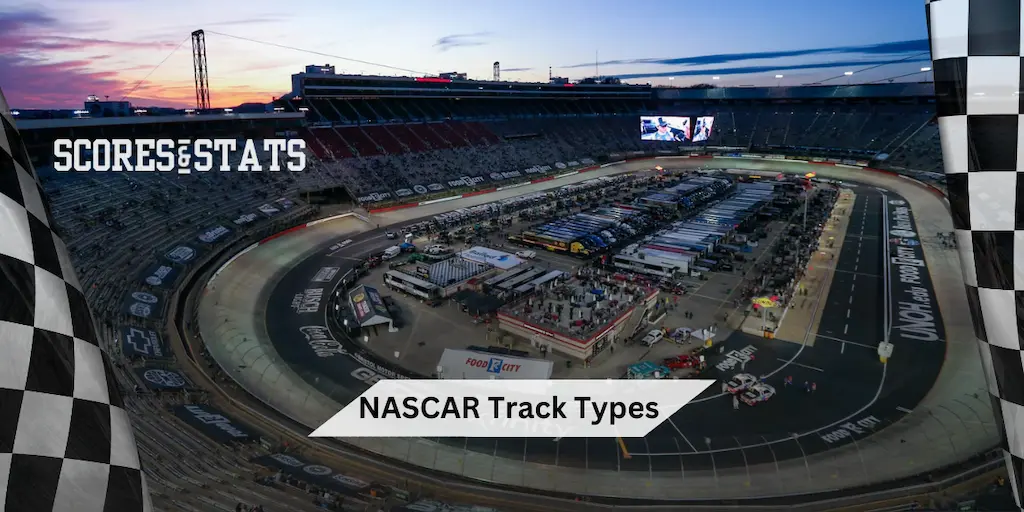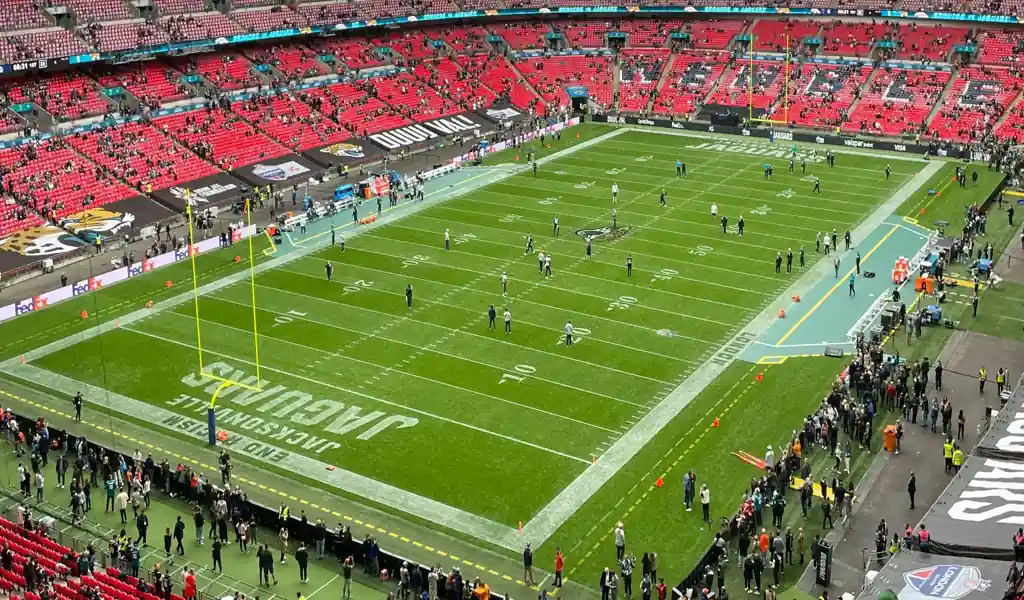Table of Contents
You may have heard the expression “all they do is make left turns” when someone jokingly describes NASCAR racing. That’s because many of the tracks in NASCAR are ovals that only require turning left.
However, that’s not the case for every track in this ever-evolving sport. In fact, there are several different types of race tracks; and some of these venues require both left and right turns.
Additionally, no two oval tracks are the same. Sure, there are “sister” tracks where they have similar traits, but they still aren’t 100% identical.
Many of these oval tracks will differ in length, types of surfaces, banking, configurations and more. And, when betting on NASCAR, it’s important to know about these race tracks before placing wagers on our NASCAR picks or the sport in general.
With that in mind, keep reading about the active NASCAR tracks on the 2025 calendar for the top National circuits: Cup Series, Xfinity Series and Craftsman Truck Series.
NASCAR Tracks
The following NASCAR tracks are currently on the schedule for the 2025 season:
| NASCAR Track | Lap Length | Banking | Type | Location |
|---|---|---|---|---|
| Atlanta Motor Speedway | 1.540 mile | Turns: 28° | Asphalt Quad-Oval | Hampton, Georgia |
| Autodromo Hermanos Rodríguez | 2.674 mile | No banking | Asphalt Road Course | Mexico City, Mexico |
| Bowman Gray Stadium | 0.25 mile | No banking | Asphalt Oval | Winston-Salem, North Carolina |
| Bristol Motor Speedway | 0.533 mile | Turns: 26°–30° Straights: 6°–10° | Concrete Oval | Bristol, Tennessee |
| Charlotte Motor Speedway | 1.5 mile | Turns: 24° Straights: 5° | Asphalt Quad-Oval | Concord, North Carolina |
| Charlotte Motor Speedway ROVAL | 2.32 mile | Turns: 24° Straights: 5° | Asphalt Road Course | Concord, North Carolina |
| Chicago Street Course | 2.14 mile | No banking | Asphalt Street Course | Chicago, Illinois |
| Circuit of the Americas (COTA) | 2.326 mile | No banking | Paved Road Course | Austin, Texas |
| Darlington Raceway | 1.366 mile | Turns 1/2: 25° Turns 3/4: 23° Frontstretch: 3° Backstretch: 2° | Asphalt Egg-Shaped Oval | Darlington, South Carolina |
| Daytona International Speedway | 2.5 mile | Turns: 31° Tri-Oval: 18° Backstretch: 2° | Asphalt Tri-Oval | Daytona Beach, Florida |
| Dover Motor Speedway | 1 mile | Turns: 24° Straights: 9° | Concrete Oval | Dover, Delaware |
| Homestead–Miami Speedway | 1.5 mile | Turns: 18°–20° Straights: 3° | Paved Oval | Homestead, Florida |
| Indianapolis Motor Speedway (Oval) | 2.5 mile | Turns: 9° Straights: 0° | Asphalt Oval Brick Start/Finish Line | Speedway, Indiana |
| Iowa Speedway | 0.875 mile | Turns: 12–14° Frontstretch: 10° Backstretch:4° | Asphalt Oval | Newton, Iowa |
| Kansas Speedway | 1.5 mile | Turns: 17°–20° Tri-Oval: 9°–11° Backstretch: 5° | Asphalt Tri-Oval | Kansas City, Kansas |
| Las Vegas Motor Speedway | 1.5 mile | Turns: 20° Tri-Oval: 12° Backstretch: 9° | Asphalt Tri-Oval | Las Vegas, Nevada |
| Lime Rock Park | 1.53 mile | No banking | Asphalt Road Course | Lakeville, Connecticut |
| Lucas Oil Indianapolis Raceway Park | 0.686 mile | Turns: 12° Straights: 0° | Asphalt Oval | Brownsburg, Indiana |
| Martinsville Speedway | 0.526 mile | Turns: 12° Straights: 0° | Asphalt/Concrete Paperclip Oval | Ridgeway, Virginia |
| Michigan International Speedway | 2 mile | Turns: 18° Frontstretch: 12° Backstretch: 5° | Paved D-Shape Oval | Brooklyn, Michigan |
| Nashville Superspeedway | 1.333 mile | Turns: 14° Tri-Oval: 8° Straights: 5° | Concrete Tri-Oval | Lebanon, Tennessee |
| New Hampshire Motor Speedway | 1.058 mile | Turns: 2°–7° Straights: 1° | Asphalt Paperclip Oval | Loudon, New Hampshire |
| North Wilkesboro Speedway | 0.625 mile | Turns: 14° Straights: 3° | Asphalt Oval | North Wilkesboro, North Carolina |
| Phoenix Raceway | 1 mile | Turns 1/2: 8° Backstretch: 3° Turns 3/4: 10°-11° Dogleg: 10°–11° Side Straight: 10° Frontstretch: 3° | Asphalt Dogleg Oval | Avondale, Arizona |
| Pocono Raceway | 2.5 mile | Turn 1: 14° Turn 2: 8° Turn 3: 6° Straights: 0° | Paved Triangular Oval | Long Pond, Pennsylvania |
| Portland International Raceway | 1.967 mile | No banking | Asphalt/Concrete Road Course | Portland, Oregon |
| Richmond Raceway | 0.75 mile | Turns: 14° Frontstretch: 8° Backstretch: 2° | Asphalt D-Shape Oval | Richmond, Virginia |
| Rockingham Speedway | 0.94 mile | Turns: 22° and 25° Straights: 8° | Asphalt D-Shape Oval | Rockingham, North Carolina |
| Sonoma Raceway | 1.99 mile | No banking | Asphalt Road Course | Sonoma, California |
| Talladega Superspeedway | 2.66 mile | Turns: 33° Tri-Oval: 17° Backstretch: 3° | Asphalt Tri-Oval | Lincoln, Alabama |
| Texas Motor Speedway | 1.5 mile | Turns 1 and 2: 20° Turns 3 and 4: 24° Straights: 5° | Asphalt Quad-Oval | Fort Worth, Texas |
| Watkins Glen International | 2.45 mile | No banking | Asphalt Road Course | Watkins Glen, New York |
| World Wide Technology Raceway | 1.25 mile | Turns 1 and 2: 11° Turns 3 and 4: 9° Straights: 3° | Asphalt Egg-Shaped Oval | Madison, Illinois |
The data found in the table above, is compiled from NASCAR’s official site and Wikipedia.
NASCAR Race Tracks
This year, NASCAR has included over 30 tracks spanning across their top three National racing circuits. However, not all of the venues will be used in all three circuits.
Cup Series: will have 29 different race tracks for the season. Charlotte’s oval track and road course are considered two different tracks.
Xfinity Series: NASCAR’s #2 National circuit will include two tracks that the Cup Series will not race on this year – Rockingham and Portland.
Truck Series: the Craftsman Trucks will race on most of the tracks that the Cup Series is competing at. However, this series has also added two different tracks – Lime Rock Park and Indianapolis Raceway Park.
Now that we have laid out all of the tracks on the 2025 NASCAR calendar for all three of the sport’s top National circuits, let’s take a look at the differences in the types of tracks.
NASCAR Short Tracks
Short tracks are any venues with a lap length of under one mile. And, within this category of NASCAR race tracks, no two short tracks are the same. Yet, the type of racing is very similar: bump and survive! Furthermore, some of these venues have held races since the early days of NASCAR.
Bowman Gray Stadium
Over the last few years, NASCAR held its exhibition Clash races at the LA Memorial Coliseum. This year, NASCAR moved the exhibition race to Bowman Gray Stadium, which is only 0.25 miles per lap. The Cook Out Clash at Bowman Gray became the first Cup race held at this ultimate short track since 1971.
Bristol Motor Speedway
Since 1961, Bristol Motor Speedway has been an annual staple on the NASCAR calendar. Often referred to as “Thunder Valley,” Bristol has undergone a few reconfigurations to keep up with the evolution of stock cars and trucks. All three series races at this venue.
Iowa Speedway
Located in Newton, Iowa, the Iowa Speedway is a short track of 0.875 miles per lap, has returned to NASCAR after a hiatus. In fact, it’s one venue that NASCAR owns outright. The Cup Series returned to action in 2024, and will race there this season.
The Xfinity Series will join in the Iowa festivities after returning last season. This series raced at the Iowa Speedway from 2009 to 2019, before a brief hiatus. The Craftsman Truck Series raced in Iowa from 2012 to 2013, but will not participate at this track in 2025.
Lucas Oil Indianapolis Raceway Park
Another short track making a return to the calendar is the Lucas Oil Indianapolis Raceway Park which held its first race in 1960. This venue also features a 2.5-mile road course as well. However, it’s the 0.686-mile short track that will be used by NASCAR.
Yet, this track will only be used by the Truck Series and not the Cup or Xfinity Series. The Craftsman Trucks have been racing here since 2022.
Martinsville Speedway
Martinsville Speedway is one of the oldest venues on the NASCAR circuit. Opened in 1947, the “Paperclip” was originally a dirt track. However, after a partnership was forged with NASCAR, the owners paved the speedway with asphalt in 1955.
Typically, Martinsville holds multiple races per year. Additionally, all three Series race at this iconic venue. Another wonderful Martinsville tradition is that the winner of the race receives a grandfather clock.
North Wilkesboro Speedway
The North Wilkesboro Speedway (NWS) is one of NASCAR’s oldest venues. Since 1949, this North Carolina racing venue has been associated with the sport. Unfortunately, NWS and NASCAR had a falling out after nearly 50 years of marriage.
In 1996, the two Cup races held at this short track were replaced with events held at Texas Motor Speedway and New Hampshire Speedway.
In 2022, the two parties reconciled and the NWS was awarded with a Truck Series race and the NASCAR Cup Series All-Star Race. From running moonshine to the All Stars of the Cup Series, this 0.625-mile short track is a vintage experience for fans and drivers alike.
Richmond Raceway
Richmond Raceway is the little guy with a big attitude. Shaped like a superspeedway, Richmond measures 0.75-miles in lap distance despite its desire to be like its bigger siblings.
Nicknamed “Action Track”, “Strawberry Hill,” and “America’s Premier Short Track,” Richmond has been part of the NASCAR calendar since 1953. That year, Lee Petty, Richard Petty’s father, won the first sanctioned race at this venue.
Until last year, Richmond held two annual Cup Races. However, the spring Richmond Cup event was replaced with NASCAR’s foray into Mexico. With that said, all three of the top circuits will hold races at Richmond this fall.
Rockingham Speedway
Rockingham Speedway, most often referred to as “The Rock,” returned to the NASCAR calendar in 2025, after a lengthy hiatus due to a falling out between the venue owners and the sport’s governing body.
Fortunately for racing fans, The Rock was added back to the calendar for the Xfinity Series and Truck Series races after the blood feud came to an end. This short track of 0.94 miles per lap, was one of the most popular venues on the circuit until 2004, when NASCAR parted ways.
NASCAR Intermediate Tracks
The Intermediate Tracks are defined as race tracks with a lap distance of one to two miles in length. Many of these types of tracks have a lap length of 1.5 miles. And, despite the variation in distance, all of the tracks found in this category offer plenty of racing action.
Atlanta Motor Speedway
The Atlanta Motor Speedway is located in Hampton, Georgia, just south of Atlanta. The track opened in 1960, and has a lap length of 1.54 miles long. Recent reconfigurations have made racing at this intermediate track a light version of Superspeedways.
Charlotte Motor Speedway
The Charlotte Motor Speedway opened in 1960, and was also used in the Elvis Presley movie Speedway. The venue is often thought of as the typical intermediate track as it sits at a lap-length of 1.5 miles long and shaped like a tri-oval.
It should be noted that CMS also has the ROVAL, which is the venue’s road course. We’ll discuss that in more detail below. Jimmie Johnson, the seven-time Cup Series champ, won eight times at Charlotte.
Darlington Raceway
Located in Darlington, South Carolina, the Darlington Raceway has been a part of the NASCAR circuit since its early days. The venue opened in 1950 and quickly earned popular monikers that are still touted to this very day – “The Track Too Tough to Tame” and my favorite nickname for any track “The Lady in Black.”
Darlington is home to two annual races for the Cup and Xfinity Series. The Truck Series also races once per year at this 1.37-mile intermediate track.
One of the sport’s most popular annual races is held at Darlington – the Southern 500. It’s often considered one of the crown jewels of Cup races.
Dover Motor Speedway
Nicknamed “The Monster Mile,” which is another cool moniker, Dover Motor Speedway opened in 1969 and has held annual races since then. The action at this intermediate one-mile track is often filled with carnage. This was another venue that Jimmie Johnson owned in his career as he won 11 times at Dover.
Homestead Miami Speedway
Is it Homestead or is it Miami? Well, it doesn’t really matter because the action is fast, intense and often crucial to determining the Cup Series Championship since its opening in 1999. In fact, this 1.5-mile Homestead-Miami Speedway used to hold the Cup Series Championship race before it was moved to Phoenix.
Now, all three of the top series race just once per year at this venue. And, those races have been moved to the same weekend in the Spring.
Kansas Speedway
Located in Kansas City, Kansas, this venue is one of the more popular tracks in the Midwest. At 1.5 miles in length, the Kansas Speedway was added to the NASCAR calendar in 2001.
Kansas is a common tri-oval shaped track with wide turns, high speeds, and plenty of room for passing. It’s very similar to Charlotte and Las Vegas Speedways. Denny Hamlin has the most Kansas wins, but Kyle Larson has dominated at Kansas Speedway over the last few years.
Las Vegas Motor Speedway
Located in Las Vegas, Nevada, “Sin City’s” premiere race track is home to two annual Cup Series and Xfinity Series races. Even the Truck Series has one annual race at Las Vegas Motor Speedway.
Also known as “America’s Racing Showplace,” this speedway started off as a home for short-track racing before incorporating the 1.5-mile-long tri-oval in the Cup Series during the 1998 season.
Michigan International Speedway
The Michigan International Speedway (MIS) is the only current NASCAR track with a two-mile lap distance. Located in Brooklyn, Michigan, roughly an hour from Detroit, MIS is a d-shaped oval that first held NASCAR races in 1969.
This venue is often held in high regard to the Ford drivers and teams as it’s considered a hometown race. However, only the Cup Series and Truck Series hold annual races at MIS. The Xfinity Series removed Michigan from their calendar.
Nashville Superspeedway
Tucked away in Lebanon, Tennessee, the Nashville Speedway is a concrete track with a lap length of 1.33 miles. The venue first opened in 2001, but the Cup Series didn’t start racing here until 2021.
However, don’t let this fool you. Nashville has been home to racing since the 1950s as the Fairgrounds were a hotbed of racing during the golden era. Darrell Waltrip cut his teeth in this region before going on to become a HOF driver.
The Xfinity and Truck Series raced at this track from 2001 until 2011, before taking a hiatus until 2021, when NASCAR scheduled annual Nashville races for all three circuits.
New Hampshire Motor Speedway
Dover might have “The Monster Mile”, but New Hampshire has “The Magic Mile.” Yes, that’s the nickname for the New Hampshire Motor Speedway located in Loudon. This venue first opened in 1989, and has held Cup Series races since 1993.
Yet, like Nashville, the New Hampshire region has had racing in its blood since the 1960s. In addition to the Cup Series, the Truck Series will also race here in 2025. The Xfinity Series will skip this 1.058-mile track.
Phoenix Raceway
The Phoenix Raceway has evolved into one of the most important intermediate tracks on the circuit. Coming in at just one-mile in lap length, this dogleg oval track holds two annual Cup races per year. The most notable of the two is the Cup Series Championship Race in November.
Additionally, both the Xfinity Championship Race and the Craftsman Truck Series Championship Race are also held at Phoenix to decide the season’s champion.
Ironically, this venue is located on Jimmie Johnson Drive in Avondale, Arizona. So, it’s clearly become hallowed grounds for the entire sport.
Texas Motor Speedway
Texas Motor Speedway, located in Forth Worth, Texas, used to hold multiple races including the All-Star race. However, since NASCAR started racing at this venue in 1997, multiple events have come and gone from “The Great American Speedway.”
With that said, this 1.5-mile-long track is known for wide turns that allow the pack of cars to sweep around the track at varying degrees of banking. Currently, all three of NASCAR’s top circuits hold annual races at this track.
World Wide Technology Raceway
Illinois is home to two annual NASCAR venues – the Chicago Street Race and the World Wide Technology Raceway located in Madison. This track is shaped like someone squeezed the end of an egg. It features a lap length of 1.25 miles and was first used for its in-field road course after opening in 1997.
The “WWT Raceway” or “Gateway” are two easier ways to remember this track that took characteristics from Darlington, New Hampshire and Phoenix to create one unique track.
The Cup Series began racing here in 2022, but Xfinity first began racing at The Gateway in 1997. It did have a lengthy hiatus from 2011 to 2024. The Truck Series raced here most years from 1998 to 2024. The trucks will skip this venue in 2025.
NASCAR Superspeedways
The superspeedways of NASCAR are some of the most popular race tracks in the sport due to their fast speeds and incredible wrecks. Additionally, they’re very popular in the entertainment world as well. Will Ferrell’s Talladega Nights is a classic pop culture example of the lores and legends surrounding superspeedways.
Additionally, Daytona International Speedway holds the sport’s most popular race – the Daytona 500. And, yet, there is one more track in this category. However, it’s often overlooked when talking about superspeedways – Pocono Superspeedway.
Daytona International Speedway
Daytona International Speedway, located in Daytona Beach, Florida, is one of the most recognized venues in all of motorsports. It’s a superspeedway that hosts two Cup Series races per year, including the most recognizable event in NASCAR – the Daytona 500.
In fact, outside of the Indy 500, you would be hard-pressed to find a more popular race than the “Super Bowl of NASCAR.” And unlike the NFL, where the Super Bowl is at the end of the season, NASCAR begins each year with its cherished Daytona 500.
Additionally, both the Xfinity Series and Truck Series hold annual events at this superspeedway with a lap length of 2.5 miles. Bump, draft, fast speeds, and big wrecks are the calling cards of Daytona.
Pocono Superspeedway
When the average NASCAR fan thinks of superspeedways, it’s usually just Daytona and Talladega. The Pocono Superspeedway is often forgotten. And, yet, since 1971, “The Tricky Triangle” is one of the more compelling venues on the docket each year.
Nestled in Blakeslee, Pennsylvania, the Pocono Superspeedway is a tri-oval track with a 2.5-mile lap length and is shaped like a rounded triangle. The most iconic turn at the track is the “Tunnel Turn” which is above the tunnel that allows access to the infield.
In addition to a Cup Series race, both the Xfinity Series (since 2016) and Truck Series (since 2010) hold annual races at this superspeedway.
Talladega Superspeedway
The ego that went into building Talladega Superspeedway was due to some of NASCAR’s leaders wanting a bigger venue than Daytona.
Well, they got that with this tri-oval track as Talladega comes in at a whopping 2.66-mile lap length. It’s the longest lap for any oval track in NASCAR. And, depending on the source, the newly added Autodromo Hermanos Rodriguez road race has the longest lap length of 2.67 miles.
The speeds at Talladega got so high (over 212 mph) that NASCAR had to implement restrictor plates to keep the cars from flying off the track. Located in Lincoln, Alabama, this massive superspeedway has been an annual staple of the Cup Series since 1969.
Both the Xfinity Series (since 1992) and the Truck Series (since 2006) make annual trips to Talladega. Like Daytona, this venue is filled with high speeds, bump drafting, and “the big one” at the end of each race.
NASCAR Road Courses
NASCAR road courses are tracks that often have longer lap distances, elevation changes, can be raced throughout city streets, and most importantly – they have right turns.
These types of tracks resemble more of the F1 racing style along with adding a pinch of road rage that many of us every-day drivers are accustomed to. Additionally, NASCAR has added some new venues for fans and drivers to enjoy some exciting changes in scenery.
Autodromo Hermanos Rodriguez
The Autodromo Hermanos Rodriguez is a race track located in Mexico City, Mexico, and was added to the NASCAR calendar for the first time this year. The venue has been home to Formula One for periods of time dating back to 1962.
The Xfinity Series raced at this venue from 2005-2008, and will return to it in 2025 alongside the Cup Series. The Truck Series will not race here this season.
As mentioned above, the Autodromo is the longest track on the NASCAR circuit this year with a lap distance of 2.67 miles. That just squeaks by Talladega.
Sadly, the track was named after the Rodriguez brothers who both died behind the wheel, nine years apart.
Charlotte Motor Speedway ROVAL
The ROVAL is one of the more ingenious tracks in all of NASCAR. This venue is a hybrid oval-road course track held at Charlotte Motor Speedway.
CMS has been part of NASCAR since 1960. However, the ROVAL didn’t join the sport until 2018, after the road course was reconfigured to be compatible with NASCAR racing.
Another notable feature about the ROVAL is that all three of the top series will use this venue as a Playoff Race in October. The hybrid track not only etched its name on the list of Playoff races, but this 2.28-mile road course has also become a hit with both fans and drivers a like.
Chicago Street Race
While Chicago has been a home to NASCAR for generations, most of the top circuits’ races stopped running at the “Windy City” in 2019. Yet, after seeing the popularity of a Chicago Street Race in an imaginary iRace, NASCAR decided bring this dream to life.
In 2023, both the Cup Series and Xfinity Series began racing at 2.14-mile circuit through the streets of downtown Chicago. The creativity and ingenuity of this circuit reminds us of cycling races throughout popular cities like Paris, London, Rome and Barcelona.
Yet, it’s even more impressive with these incredible machines blazing through the streets of Chicago. It’s like the “Fast and the Furious” meets Formula One.
With that said, both the Cup Series and Xfinity Series will hold Chicago Street Races this year. The Truck Series will not participate at this circuit.
Circuit of the Americas (COTA)
Circuit of the Americas, known as COTA for short, is a state-of-the-art motorsports facility that has housed a number of different types of racing over the years.
Located in Austin, Texas, COTA opened in 2012 and instantly became a hit with the fans. With over 19 turns, the NASCAR version of this road course spans just under 2.4 miles per lap. The larger Grand Prix Circuit comes in at 3.426 miles per lap.
Both the Cup Series and Xfinity Series will race at COTA in 2025. However, the Truck Series has opted for other road courses which we will see below.
Lime Rock Park
Built in 1956, Lime Rock Park has been a part of racing since the late-50s. However, NASCAR’s top circuits have never raced at this track until now. Before this, NASCAR’s smaller, regional circuits raced at Lime Rock up until roughly 15 years ago.
With that said, the Craftsman Truck Series will be NASCAR’s guinea pig as they compete at this 1.53-mile road course located in Lakeville, Connecticut.
Since 2023, the owners of Lime Rock Park have worked with NASCAR to ensure the venue meets the sport’s criteria. If all goes well, this road course could become an annual staple for the Truck Series. And if it becomes more popular, then it could host a Cup or Xfinity race.
Portland International Raceway
The Portland International Raceway (PIR) first opened in 1961, and has been home to various types of racing since then. NASCAR has held various racing events at this venue spanning across their smaller circuits.
The first of the big three National Series to race here was the Craftsman Trucks. The Truck Series competed at PIR in 1999 and 2000.
It wasn’t until 2022, that one of the big three returned. However, this time, it was the Xfinity Series. Since then, Xfinity has made PIR an annual race.
The PIR is described as a flat road course that runs clockwise with 12 turns and a lap distance of 1.967 miles.
Sonoma Raceway
Other than the 2020 year of Covid, the Sonoma Raceway has been an annual mainstay in the Cup Series since 1989. This road course is located at Sears Point in Sonoma, California, and it’s the only remaining NASCAR Cup Series race still running in the Golden State.
For at least three decades, Sonoma and Watkins Glen were the only two road races in the Cup Series. This year, the Cup drivers will compete in six road races. There are eight total road races spanning all three of the top NASCAR Series.
The course itself, spans 2.52 miles long with 12 turns and a total elevation gain of 160 feet. There’s no other race like Sonoma.
Watkins Glen International Raceway
Watkins Glen International Raceway, also as “The Glen,” is located in Watkins Glen, New York. This road race is the oldest running road race in the Cup Series. The first Cup races were held in the 50s and 60s. However, it didn’t become an annual tradition until 1986.
Joining the Cup Seres at The Glen, is the Xfinity Series which has been running at Watkins Glen since 1991 as well.
Unlike other racing organizations, NASCAR runs the short circuit with inner loop chicane. This circuit has a lap length of 2.45 miles and features eight turns. The short circuit was added in 1971.
The Glen was first raced as an open public road course that spanned 4.6 to 6.6 miles after multiple configurations. A Grand Prix Circuit was implemented in 1956. Yet, Formula One inspired this venue to create the long circuit known as The Boot (3.37 miles), along with the previously mentioned short one.















